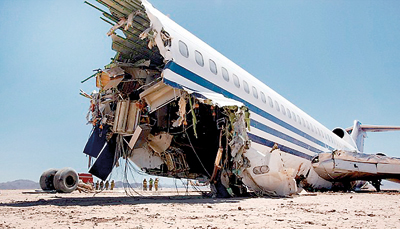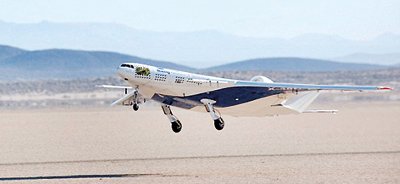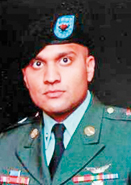Sunday Times 2
It pays to fly economy
First class air travel offers plenty of perks but it seems that increased safety isn’t one of them. New research has revealed that economy passengers are more likely to survive a plane crash than those sitting in more expensive seats at the front of the plane.
Scientists conducted an experiment in which they crashed a Boeing 727 carrying dummies with breakable bones, cameras and sensors into the Sonaran desert in Mexico.
Three crash-test dummies were arranged in three different positions on board the plane: one in the classic brace and wearing a seat-belt; one belted but not in the brace position; and one neither belted nor in the brace. After the pilot parachuted out of the plane at 2,500ft, the jet was guided towards the ground by a pilot in a following Cessna via a remote-control device.

Wrecked: The deliberate crash-landing shows how devastating such an impact can be on the front
During the $1.5 million experiment – which was arranged by Channel 4 and television production company Dragonfly – the first 11 rows of seats ripped out as the nose of the plane dipped and the front of the fuselage sheared off. These rows would usually be where the most expensive seats would be located.
A force of 12G was recorded in the front of the remaining cabin while, further back in the plane, the force dropped to 6G.
Experts concluded that no first-class passengers would have survived the impact but 78 per cent of the remaining passengers would have lived, with the chances of survival increasing the further back they were seated.
They also found that the dummy in the brace position would have survived the impact, the one not in the brace would have suffered serious head injuries, and the dummy not wearing a seat-belt would have perished.The crash will be screened on Channel 4 next month and was aimed at helping scientists to study the crash-worthiness of the aircraft’s frame and cabin, as well as the impact on the human body.
It is hoped that the findings may help increase the chances of passengers surviving such a crash in the future.
It is only the second time that a jet has been crash-tested this way – the first ‘controlled impact demonstration’ of a Boeing 720 by Nasa in 1984 ended up as a fireball in California’s Mojave Desert.
Anne Evans, a former investigator at the UK’s Air Accidents Investigation Branch, inspected the 727′s black-box data recorder after the event.She said the outcome proved that today’s jets, which are more sophisticated than the 727 used in the experiment, were well equipped to cope with such crashes.
‘It is safer to sit at the back of the aircraft where the flight recorder is. The front is more vulnerable because that often sees higher impact forces.
‘I would pick somewhere which is comfortable and within a few rows of an emergency exit’, she said. Sanjay Sighal, creative director at Dragonfly told the Sunday Times: ‘Planes are sold entirely on comfort, food, entertainment systems, space in your business class seat and so on. They are never sold on the safety indications.
‘That’s partly why I don’t think it’s been in anyone’s interest to do a test like this.’
© Daily Mail, London
Follow @timesonlinelk
comments powered by Disqus

























